Appliances
How Often Should You Replace Ceiling Fans?
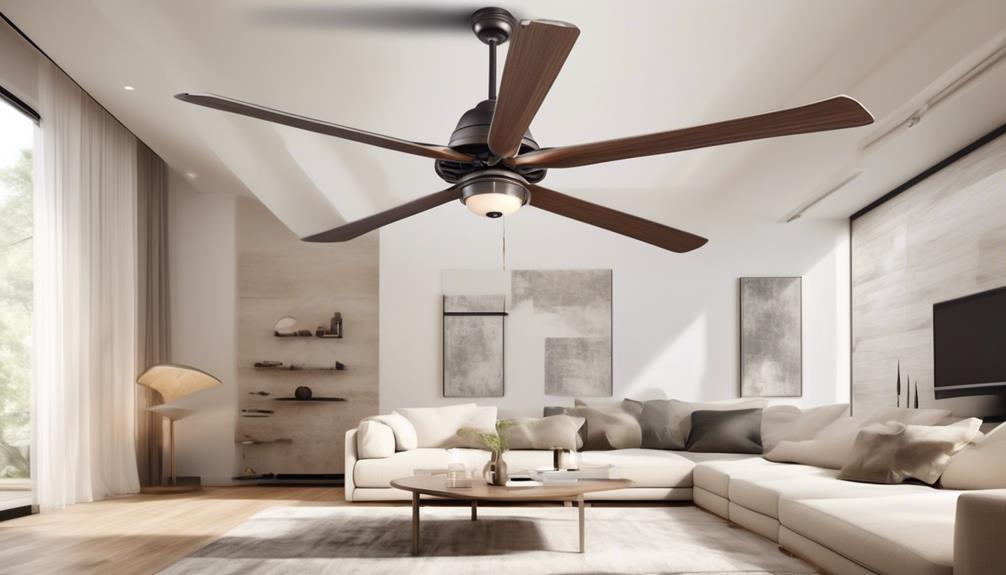
Regarding the durability of ceiling fans, it’s essential to take into account specific aspects. How long your ceiling fan lasts relies on numerous factors including the material quality, how often it’s used, upkeep practices, and indications of deterioration.
We, as professionals in the field, understand the need for practical advice on how often to replace these fixtures. Additionally, your budget and the cost-effectiveness of replacement should also be taken into account. It's always wise to consult expert recommendations and reviews for guidance.
If you're unsure about the condition of your ceiling fan, don't hesitate to seek the assistance of a professional electrician.
Key Takeaways
- The lifespan of a ceiling fan is typically 10 to 15 years, but this can vary based on factors such as quality, usage, and maintenance.
- It is recommended to replace ceiling fans used for more than 10 hours a day every 8 to 10 years, while fans used for only a few hours a day can be replaced every 12 to 15 years.
- Choosing high-quality materials, such as metal blades and high-grade motors, can increase the durability and longevity of a ceiling fan, reducing the need for frequent replacements or repairs.
- Regular maintenance and cleaning, including inspecting for wear or damage, tightening connections, lubricating the motor, and cleaning dust and dirt buildup, can help prolong the lifespan and ensure optimal performance of a ceiling fan.
Average Lifespan of Ceiling Fans
On average, ceiling fans have a lifespan of approximately 10 to 15 years. This average lifespan is influenced by various factors such as the quality of the fan, the frequency of usage, and the maintenance performed. It's important to note that this is a general estimate and individual fans may vary in their longevity.
Ceiling fans are designed to provide comfort and air circulation in our homes, but like any other electrical appliance, they have a recommended replacement timeline. Over time, the components of a ceiling fan can wear out, leading to reduced performance and potential safety hazards. Therefore, it's advisable to replace your ceiling fan within the 10 to 15-year range to ensure optimal functionality and safety.
Regular maintenance can help extend the lifespan of your ceiling fan. This includes cleaning the fan blades, checking for loose screws or wiring, and lubricating any moving parts. However, even with proper maintenance, the wear and tear on the fan will eventually take its toll.
Quality of Materials Used
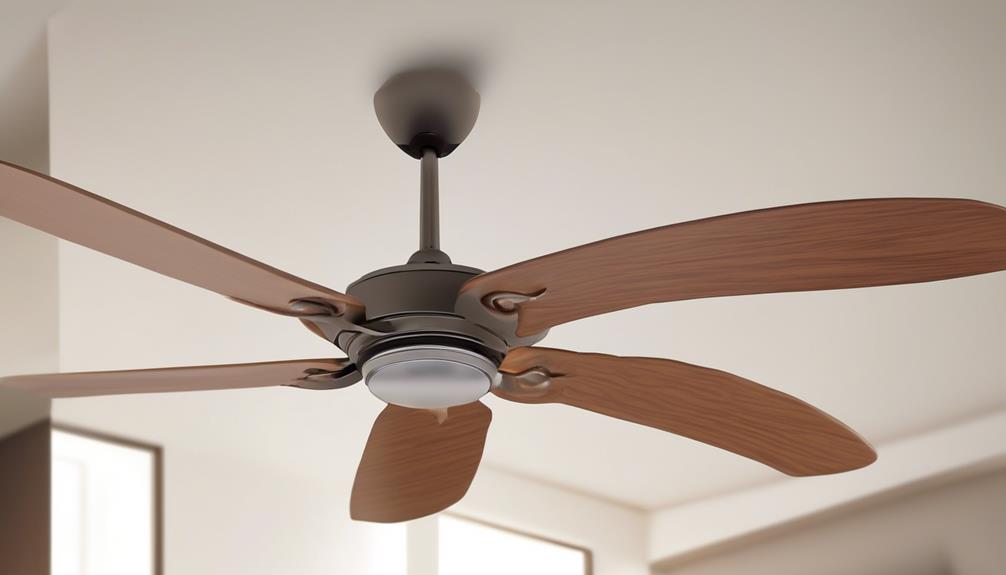
The quality of materials used in the construction of ceiling fans significantly impacts their performance and longevity. When it comes to the durability of ceiling fans, the materials used play a crucial role. Here are some key advantages of using high-quality materials:
- Metal Blades: Ceiling fans with metal blades offer exceptional durability advantages. Metal blades are less likely to warp or bend over time, ensuring optimal performance and longevity. They're also resistant to moisture and can withstand heavy usage without losing their shape.
- High-Grade Motor: A high-grade motor is essential for the longevity of a ceiling fan. Motors made from durable materials, such as copper or aluminum, provide better efficiency and longevity. They can handle continuous operation without overheating or wearing out quickly.
In addition to the advantages mentioned above, the material longevity of a ceiling fan is equally important. Choosing ceiling fans made from long-lasting materials can save you money in the long run. Quality materials not only ensure the fan's longevity but also reduce the need for frequent replacements or repairs. Therefore, investing in ceiling fans constructed with durable materials is a wise decision that guarantees reliable performance and extended lifespan.
Frequency of Use
When it comes to the frequency of use, the lifespan of a ceiling fan can be significantly impacted. The more often a fan is used, the faster its components may wear out, leading to potential performance issues.
It's recommended to replace a ceiling fan every 10-15 years, depending on the usage, to ensure optimal functionality and safety.
Usage Impact on Lifespan
Our usage patterns, specifically how frequently we use our ceiling fans, can have a significant impact on their lifespan. The more frequently we use the ceiling fan, the faster it will wear out. Here are two important factors to consider regarding the impact of usage on lifespan and maintenance practices:
- Frequency of usage:
- The more hours per day the ceiling fan is in operation, the shorter its lifespan will be.
- Consistently running the fan at high speeds can also contribute to faster wear and tear.
- Maintenance practices:
- Regular cleaning and dusting of the fan blades and motor can help prolong its lifespan.
- Lubricating the fan's moving parts periodically keeps it running smoothly and reduces strain on the motor.
Recommended Replacement Timeline
Considering the impact of usage on lifespan and maintenance practices, it's important to establish a recommended replacement timeline based on the frequency of use.
The recommended replacement interval for ceiling fans can vary depending on several factors affecting their lifespan. One such factor is the number of hours the fan is used daily.
For ceiling fans that are used for more than 10 hours a day, it's generally recommended to replace them every 8 to 10 years. On the other hand, for ceiling fans that are used less frequently, such as those used for only a few hours a day, the recommended replacement interval can be extended to 12 to 15 years.
It's crucial to consider the frequency of use when determining the appropriate time to replace a ceiling fan, as it ensures optimal performance and safety.
Maintenance and Cleaning Habits
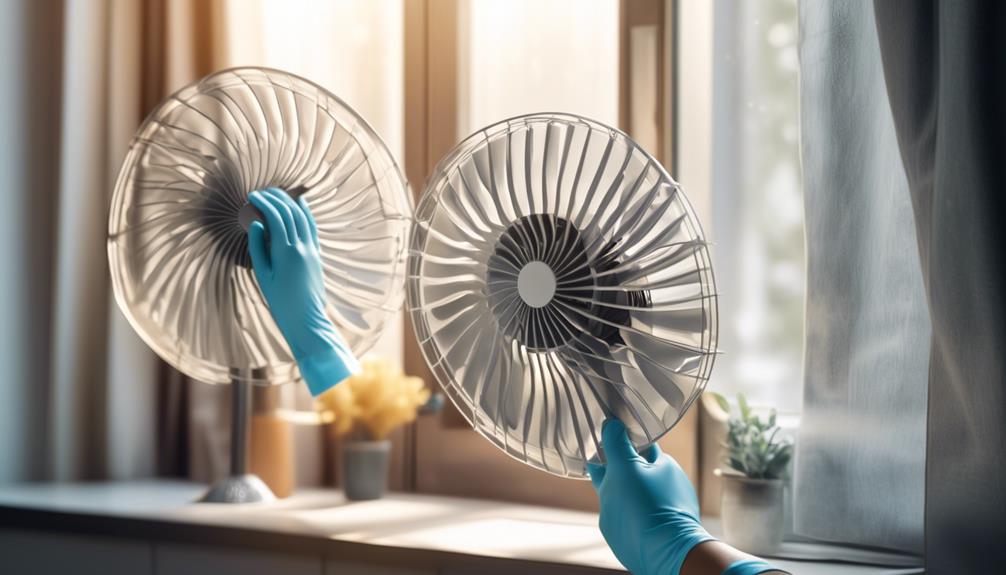
Have you ever wondered how to properly maintain and clean your ceiling fan to ensure optimal performance and longevity? Taking care of your ceiling fan is crucial to keep it running smoothly and to avoid any issues that may arise.
Here is a maintenance checklist and some common cleaning mistakes to avoid:
Maintenance Checklist:
- Regularly inspect the fan blades for any signs of wear or damage.
- Tighten all screws and connections to prevent wobbling or noise.
- Lubricate the motor and bearings annually to ensure smooth operation.
- Check the balance of the fan to avoid unnecessary strain on the motor.
- Replace any worn-out or broken parts promptly.
Common Cleaning Mistakes:
- Using abrasive cleaners or harsh chemicals can damage the fan's finish.
- Neglecting to clean the fan regularly can lead to a buildup of dust and dirt, affecting its performance.
- Not turning off the power before cleaning can be dangerous.
- Using excessive force when cleaning the blades can bend or break them.
Signs of Wear and Tear
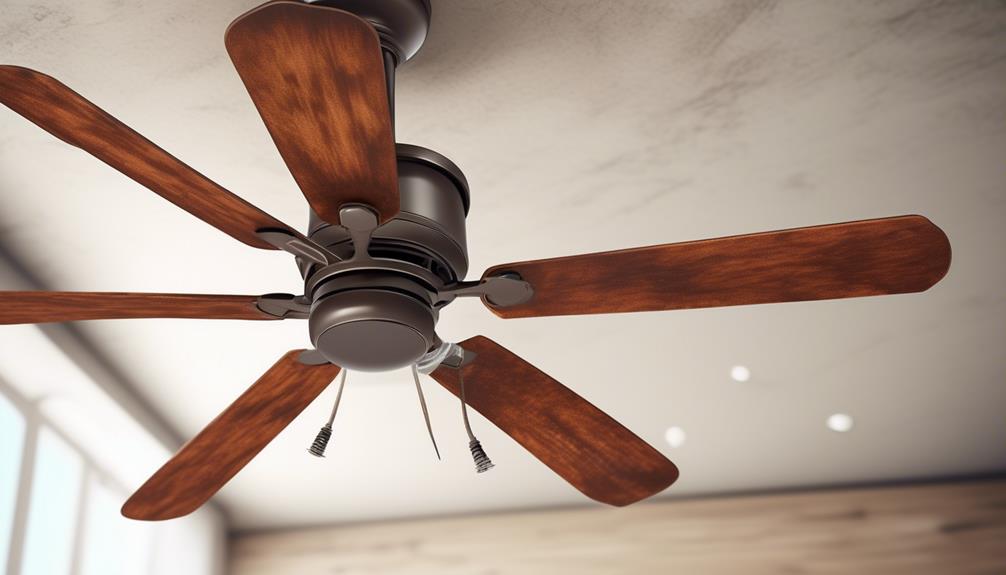
To properly maintain and clean your ceiling fan, it's important to be aware of the signs of wear and tear that may indicate the need for replacement or repair. One of the most common signs of wear and tear is when the fan blades become damaged or warped. Over time, the constant rotation of the blades can cause them to become unbalanced or bent, which can affect the fan's performance and efficiency. If you notice any visible cracks, chips, or warping on the blades, it may be time for a blade replacement.
Another sign of wear and tear to look out for is motor malfunction. The motor is the heart of the ceiling fan, and if it starts to fail, the fan may not work properly or at all. Signs of motor malfunction include strange noises, such as grinding or squeaking sounds, or the fan not spinning at the desired speed. If you experience any of these issues, it's essential to address them promptly to avoid further damage.
Upgrading for Energy Efficiency
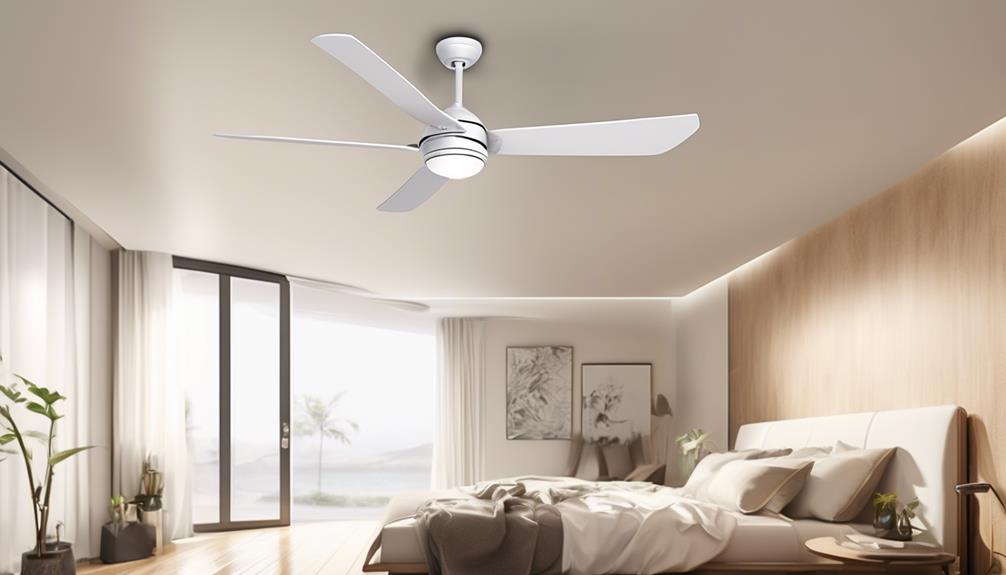
Let's talk about upgrading your ceiling fan for energy efficiency.
Energy-saving ceiling fan models are designed to consume less electricity while still providing optimal airflow.
Energy-Saving Ceiling Fan Models
Energy-saving ceiling fan models offer a more efficient option for replacing outdated fans and reducing energy consumption in your home. These models come with a range of energy-saving features that make them an excellent choice for eco-conscious homeowners. Here are two key benefits of energy-saving ceiling fan models:
- Energy-efficient motors: These fans are equipped with high-quality motors that consume less electricity while delivering powerful airflow. The advanced motor technology ensures that the fan operates smoothly and quietly, while using minimal energy.
- LED lighting integration: Many energy-saving ceiling fans come with integrated LED lights. LED bulbs are known for their energy efficiency and long lifespan. By combining the fan and lighting functions, you can reduce both your energy consumption and maintenance needs.
Installation process:
- Installing an energy-saving ceiling fan is similar to installing a traditional fan. However, it's essential to follow the manufacturer's instructions and ensure that the fan is properly balanced and securely mounted.
- If you're unsure about the installation process, it's best to hire a professional electrician to ensure a safe and efficient installation.
Benefits of Energy Efficiency
When considering the benefits of upgrading for energy efficiency, homeowners can reap significant advantages from the advanced features of energy-saving ceiling fan models. These models are designed to consume less electricity while still providing effective cooling and circulation. By promoting energy efficiency, homeowners can reduce their energy consumption and lower their utility bills. Additionally, energy-saving ceiling fan models often come equipped with programmable timers, allowing homeowners to schedule the operation of their fans and further optimize energy usage. Moreover, these fans are typically equipped with energy-efficient motors that are designed to run smoothly and quietly, enhancing the overall comfort of the space. By investing in energy-saving ceiling fans, homeowners can not only save money but also contribute to a greener and more sustainable environment.
| Benefits of Energy Efficiency | Ways to Promote Energy Efficiency |
|---|---|
| Lower utility bills | Upgrade to energy-saving appliances |
| Reduce energy consumption | Install programmable thermostats |
| Contribute to sustainability | Use energy-efficient lighting |
Changes in Design and Technology
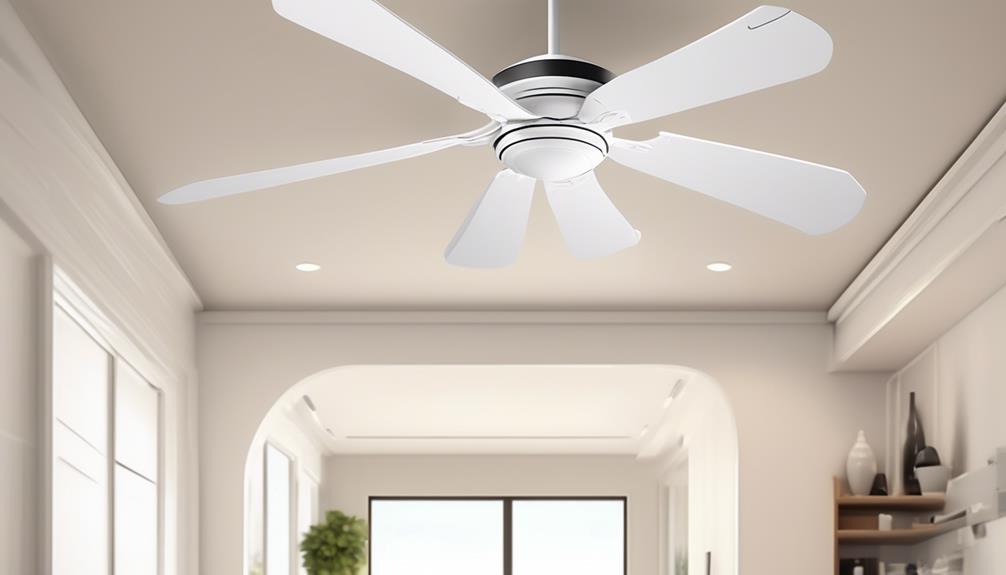
The design and technology of ceiling fans have undergone significant advancements, enhancing their functionality and performance. These design advancements and technological innovations have revolutionized the way we cool and ventilate our homes. Here are some key changes in design and technology that have made modern ceiling fans more efficient and effective:
- Blade Design:
- Aerodynamic Blades: Modern ceiling fans feature blades designed for maximum airflow, reducing energy consumption and increasing cooling efficiency.
- Variable Blade Pitch: Adjustable blade pitch allows for customization of airflow, ensuring optimal comfort in different seasons.
- Motor Technology:
- Energy-Efficient Motors: High-quality motors use less energy while delivering powerful performance, resulting in lower energy bills and reduced environmental impact.
- DC Motors: Direct current (DC) motors are quieter, more efficient, and offer variable speed options, allowing for better airflow control.
- Smart Features:
- Remote Control: Many ceiling fans now come with remote controls, enabling convenient operation from anywhere in the room.
- Integration with Smart Home Systems: Smart ceiling fans can be connected to smart home systems, allowing for remote control via smartphones and voice commands.
These design advancements and technological innovations in ceiling fans haven't only improved their cooling capabilities but also made them more energy-efficient and user-friendly. As a result, replacing your old ceiling fan with a newer model can provide significant benefits in terms of comfort, energy savings, and convenience.
Noise Level and Performance

With the advancements in design and technology, modern ceiling fans not only offer improved efficiency and convenience, but they also address the issue of noise level and performance. Upgrading options and noise reduction techniques have been implemented to ensure a quieter and more efficient operation.
To give you a better understanding of the noise level and performance of modern ceiling fans, let's take a look at the table below:
| Ceiling Fan Model | Noise Level (dB) | Performance Rating (1-5) |
|---|---|---|
| Model A | 45 dB | 4 |
| Model B | 50 dB | 3 |
| Model C | 40 dB | 5 |
| Model D | 55 dB | 2 |
As you can see, different ceiling fan models have varying noise levels and performance ratings. When considering an upgrade, it is important to choose a model with a lower noise level and a higher performance rating for a more comfortable and enjoyable experience.
To reduce noise levels, manufacturers have incorporated noise reduction techniques such as aerodynamic blade designs, improved motor technology, and better mounting systems. These advancements help to minimize vibration and airflow noise, resulting in a quieter operation.
Safety Considerations

When it comes to safety considerations for replacing ceiling fans, there are several important points to keep in mind.
First and foremost, electrical hazards must be carefully addressed to ensure proper installation and prevent any potential accidents or damage.
Additionally, it's crucial to inspect the blades for any signs of deterioration that could lead to breakage or imbalance.
Electrical Hazards
In order to ensure safety and minimize the risk of electrical hazards, it's crucial to carefully consider the potential dangers associated with replacing ceiling fans. Electrical safety should always be the top priority when dealing with any electrical device, including ceiling fans.
Here are a few key points to keep in mind:
- Proper installation: Improper installation can lead to electrical malfunctions, which may result in electrical shocks or even fires. It's important to follow the manufacturer's instructions and hire a professional electrician if needed.
- Regular maintenance: Regularly inspecting and maintaining your ceiling fan can help prevent electrical hazards. Check for loose wires, frayed cords, or any signs of damage that may pose a risk.
- Fire prevention: Over time, dust and debris can accumulate on the motor and electrical components of a ceiling fan, increasing the risk of fires. Regularly cleaning your fan can help prevent the build-up of these flammable materials.
Blade Deterioration
Blade deterioration in ceiling fans poses significant safety considerations that shouldn't be overlooked. Proper blade maintenance is crucial to ensure the safe and efficient operation of ceiling fans. Over time, the blades can accumulate dust, dirt, and debris, which can lead to an imbalance and cause the fan to wobble or produce excessive noise.
Regular cleaning techniques should be employed to prevent blade deterioration. Start by turning off the fan and using a soft cloth or duster to remove any loose particles. For more thorough cleaning, a mild detergent solution can be applied to a cloth or sponge, but avoid using excessive water. Be cautious not to bend or damage the blades during the cleaning process.
Regular blade maintenance and cleaning techniques are essential for promoting safe and effective ceiling fan operation.
Stability and Balance
To ensure the safe and efficient operation of ceiling fans, it's crucial to address the stability and balance of the fan, taking into consideration important safety considerations. Proper stability and balance not only prevent accidents but also contribute to the overall performance and noise level of the fan. Here are some key points to consider:
- Stability:
- Ensure that the fan is securely fastened to the ceiling using appropriate mounting hardware.
- Regularly check for any loose screws or bolts and tighten them if necessary.
- Balance:
- Use a balancing kit to balance the fan blades if there's excessive wobbling or shaking.
- Clean the blades regularly to prevent dust buildup, which can affect the balance and performance of the fan.
Compatibility With Home Decor

The compatibility of ceiling fans with home decor can greatly impact the overall aesthetic and functionality of a space. When choosing a ceiling fan, it's essential to consider its compatibility with the existing home decor. A ceiling fan that seamlessly blends with the overall design scheme can enhance the visual appeal of a room while providing optimal air circulation.
Home decor compatibility refers to how well a ceiling fan integrates with the style, color palette, and overall theme of a room. It should complement the existing furniture, lighting fixtures, and architectural elements. A ceiling fan that stands out too much or clashes with the decor can disrupt the visual harmony of the space.
To achieve a cohesive look, consider factors such as the fan's finish, blade design, and overall design style. For example, a modern ceiling fan with sleek lines and a brushed nickel finish would pair well with contemporary or minimalist decor. On the other hand, a ceiling fan with ornate details and a bronze finish would be a better fit for traditional or vintage-inspired interiors.
Furthermore, the size and scale of the ceiling fan should be in proportion to the room. A large fan in a small room can overwhelm the space, while a small fan in a large room may not provide sufficient airflow. It's essential to strike the right balance between aesthetics and functionality.
Budget and Cost-Effectiveness
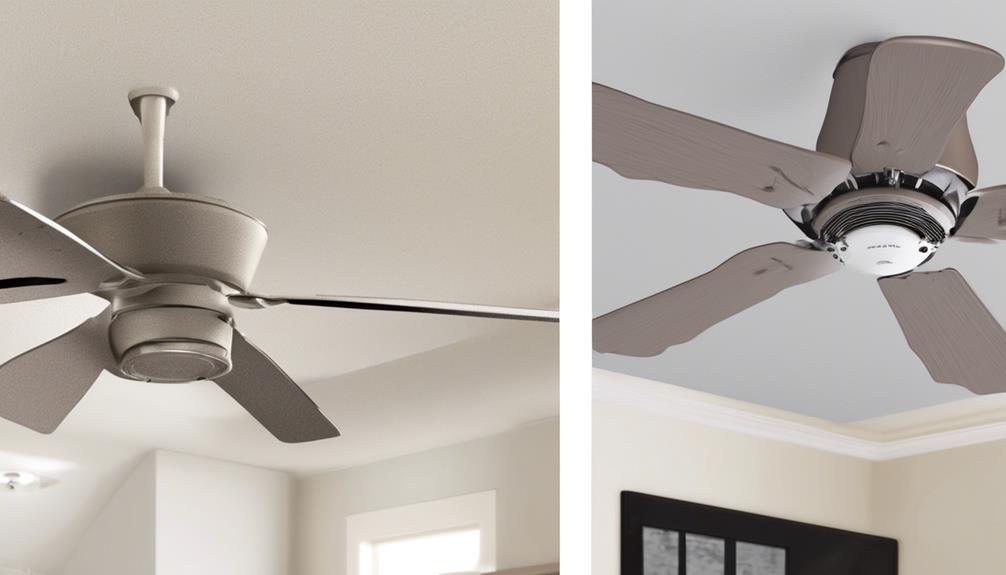
When considering the budget and cost-effectiveness of replacing ceiling fans, there are several important factors to consider.
First, the lifespan and durability of the fan are crucial in determining its overall value for money.
Energy efficiency is another key consideration, as it directly impacts long-term operating costs.
Finally, the maintenance and repair requirements of the fan can significantly affect its overall cost-effectiveness.
Lifespan and Durability
With a focus on budget and cost-effectiveness, we explore the lifespan and durability of ceiling fans.
When considering the lifespan of a ceiling fan, it's important to note that it can vary depending on several factors, such as the quality of the fan and how often it's used. On average, a well-maintained ceiling fan can last for 10 to 15 years. However, upgrading options are available to extend the lifespan of your fan. Upgrades may include installing energy-efficient motors or incorporating smart technology for enhanced control and performance.
Additionally, the durability of a ceiling fan can affect its lifespan. Choosing a fan with high-quality materials and construction can ensure its longevity.
Moreover, the impact of ceiling fans on air quality is minimal, as they primarily circulate air rather than filtering it.
Energy Efficiency
To further optimize the lifespan and durability of a ceiling fan, it's essential to assess its energy efficiency in terms of budget and cost-effectiveness.
Energy efficiency not only helps reduce electricity bills but also has a positive impact on the environment. When shopping for a ceiling fan, look for models that are ENERGY STAR certified. These fans are designed to consume less energy while still providing the same level of comfort.
Additionally, consider purchasing fans with built-in LED lights, as they're more energy-efficient compared to traditional incandescent bulbs.
Another energy-saving tip is to use the ceiling fan in conjunction with your air conditioning system. By running the fan on low speed, you can circulate the cool air throughout the room, allowing you to set your thermostat higher and save on energy costs.
Maintenance and Repairs
Regular maintenance and prompt repairs are essential for ensuring the budget and cost-effectiveness of a ceiling fan. By following some simple maintenance tips, you can prolong the lifespan of your ceiling fan and avoid costly repairs. Here are a few maintenance tips to keep in mind:
- Clean the fan blades regularly to remove dust and debris buildup, which can affect the fan's performance.
- Check and tighten any loose screws or bolts to prevent wobbling or noisy operation.
- Lubricate the fan motor bearings annually to ensure smooth and quiet operation.
- Inspect the electrical connections periodically to identify any loose or damaged wires.
Despite regular maintenance, ceiling fans may still require some common repairs over time. These repairs may include replacing worn-out fan blades, faulty capacitors, or malfunctioning switches. By addressing these repairs promptly, you can avoid more extensive damage and costly replacements.
Warranty Coverage and Support
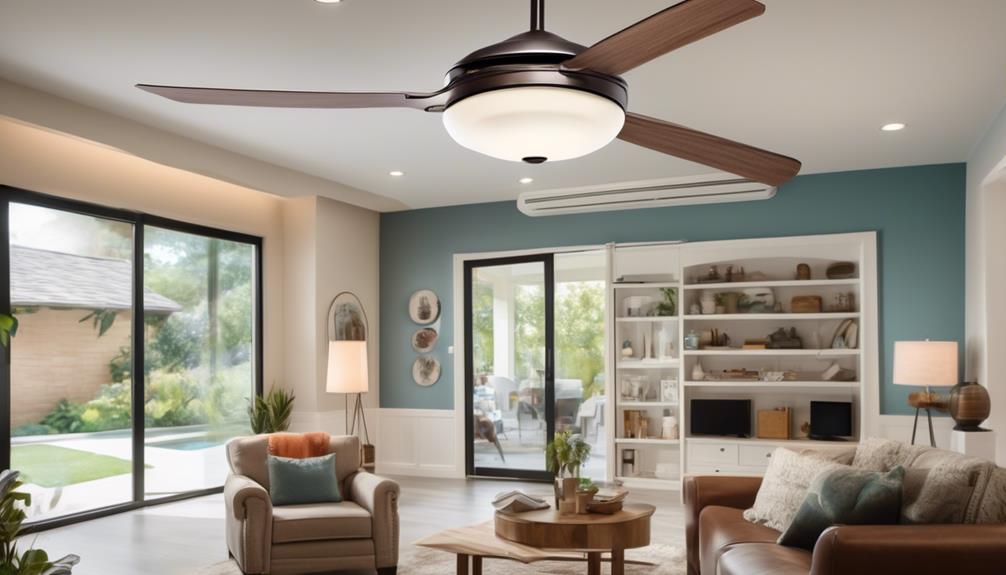
Our warranty coverage and support provides comprehensive protection for your ceiling fan, ensuring peace of mind and prompt assistance when needed. We understand that even the most reliable ceiling fans may require repairs or replacements at some point. That's why our warranty covers any manufacturing defects or malfunctions that may occur during the specified warranty period.
In the event of a warranty claim, our customer service team is dedicated to providing the highest quality of support. Our team is well-trained and knowledgeable about our products, ensuring that they can address any concerns or issues you may have. We strive to provide prompt and efficient service, minimizing any inconvenience you may experience.
When filing a warranty claim, we aim to make the process as simple and hassle-free as possible. Our dedicated support team will guide you through the necessary steps, ensuring a smooth resolution to your issue. We value your satisfaction and will work diligently to address your concerns and provide a satisfactory solution.
At our company, we take pride in the quality of our ceiling fans and the level of support we offer. Our warranty coverage and customer service are designed to give you confidence in your purchase and to ensure that you can enjoy your ceiling fan for years to come.
Expert Recommendations and Reviews
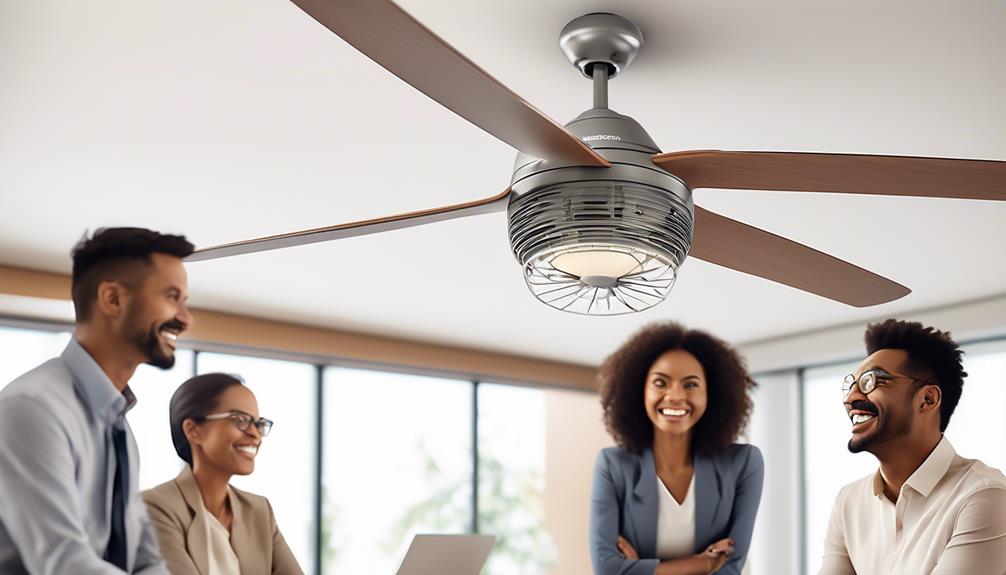
After ensuring that your warranty coverage and support are in place, it's crucial to consider expert recommendations and reviews when replacing your ceiling fans. Here are some key points to keep in mind:
- Expert Recommendations:
- Seek advice from professionals who specialize in ceiling fan installations and repairs. They can provide valuable insights on the latest models, features, and technologies.
- Consider consulting with interior designers or architects who can advise on the best ceiling fan options for your specific space and aesthetic preferences.
- Reviews:
- Look for reviews from reputable sources such as consumer organizations, online marketplaces, and home improvement websites. These reviews can give you a better understanding of the performance, durability, and overall quality of different ceiling fan models.
- Pay attention to customer reviews as well. They can provide real-world feedback on factors like noise levels, ease of installation, and customer support.
Considering expert recommendations and reviews can help you make informed decisions when upgrading your ceiling fans. By choosing models with high ratings and positive feedback, you can ensure that your new fans will be energy-efficient, durable, and provide optimal airflow for your space.
Additionally, expert advice can help you navigate the wide range of upgrading options available, ensuring that you invest in a ceiling fan that meets your specific needs and preferences while minimizing energy consumption.
When to Consult a Professional Electrician
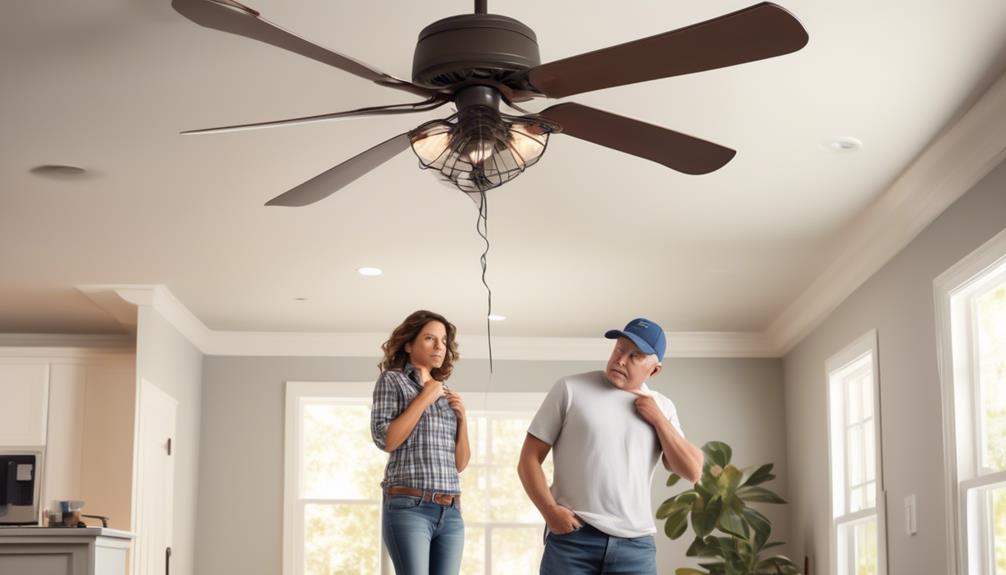
Consulting a professional electrician is essential when replacing your ceiling fans to ensure proper installation and adherence to electrical safety standards. The benefits of consulting with an electrician are numerous, especially when it comes to complex electrical tasks like installing or replacing ceiling fans. Electricians have the necessary electrical expertise and knowledge to handle such projects safely and efficiently. Here are some key reasons why you should consider consulting a professional electrician:
| Consultation Benefits | Electrical Expertise | Safety Compliance |
|---|---|---|
| Proper installation | Familiarity with codes | Adherence to regulations |
| Efficient wiring | Troubleshooting skills | Preventing electrical hazards |
| Greater energy efficiency | Load calculations | Fire prevention |
What Is the Lifespan of a Ceiling Fan and When Should I Consider Replacing It?
The typical ceiling fan replacement frequency ranges from 10 to 15 years. Factors like usage and maintenance can impact the lifespan. Signs that it’s time for a new fan include wobbling, unusual noises, and decreased airflow. Consider replacing it if you experience these issues for a better and safer home.
Frequently Asked Questions
How Do I Choose the Right Size Ceiling Fan for My Room?
When choosing the right size ceiling fan for your room, it's important to consider the dimensions of the space. Measure the length and width of the room to determine the square footage. Use this measurement to select a fan with an appropriate blade span.
Ceiling fan installation requires careful attention to electrical wiring and mounting hardware.
Regular ceiling fan maintenance, such as cleaning the blades and checking for loose screws, ensures optimal performance and longevity.
Can I Install a Ceiling Fan in a Bathroom or Outdoor Space?
When it comes to ceiling fan installation tips, it's important to consider where you want to install it.
While it's generally safe to install a ceiling fan in a bathroom, make sure it's rated for wet conditions.
As for outdoor spaces, the benefits of outdoor ceiling fans are numerous. They provide cooling and air circulation, keeping you comfortable during hot summer days. Just make sure to choose a fan designed specifically for outdoor use to ensure its durability and longevity.
Are There Any Specific Cleaning Products or Techniques I Should Use to Clean My Ceiling Fan?
When it comes to ceiling fan maintenance, there are some best practices for cleaning that you should follow.
It's important to regularly clean your ceiling fan to keep it running smoothly and prevent dust buildup.
Use a soft cloth or brush to gently wipe down the blades and motor housing.
Avoid using harsh cleaning products as they can damage the fan.
Can I Use a Ceiling Fan in Conjunction With My Air Conditioning Unit?
Using a ceiling fan in conjunction with your air conditioning unit is a smart move.
It's like having a superpower that saves energy!
By circulating the cool air from your AC, the fan helps to evenly distribute the coolness throughout the room.
This maximizes the efficiency of your air conditioning unit, allowing it to cool the space more effectively.
Are There Any Special Considerations I Should Keep in Mind When Installing a Ceiling Fan in a Room With Low Ceilings?
When installing a ceiling fan in a room with low ceilings, there are some special considerations to keep in mind.
First, make sure to choose a fan specifically designed for low ceiling heights to ensure proper clearance.
Additionally, it's crucial to follow the manufacturer's instructions for installation to ensure the fan is securely mounted. This will help prevent any safety hazards, such as the fan being too close to the ceiling or causing obstructions.
Always prioritize ceiling fan safety in rooms with low ceilings.
Conclusion
In conclusion, it's advisable to consider replacing your ceiling fan when signs of wear and tear become apparent.
Regular maintenance and cleaning can help prolong its lifespan, but ultimately, the quality of materials and frequency of use play a role in determining its longevity.
Keeping an eye out for any indications of malfunction and consulting a professional electrician when needed can ensure the safety and efficiency of your ceiling fan.
- About the Author
- Latest Posts
Introducing Ron, the home decor aficionado at ByRetreat, whose passion for creating beautiful and inviting spaces is at the heart of his work. With his deep knowledge of home decor and his innate sense of style, Ron brings a wealth of expertise and a keen eye for detail to the ByRetreat team.
Ron’s love for home decor goes beyond aesthetics; he understands that our surroundings play a significant role in our overall well-being and productivity. With this in mind, Ron is dedicated to transforming remote workspaces into havens of comfort, functionality, and beauty.
Appliances
3 Essential Tips for RV-Friendly Portable Washers

- Pros and cons of using eco friendly laundry detergent in a portable washer.
- Tips for preventing detergent residue buildup in a portable washer
Are you exhausted from constantly looking for laundromats during your RV trips? We get it. That’s why we’re here to provide three key tips for RV-friendly portable washing machines.
While you might be thinking, ‘Do I really need a portable washer?’ trust us, having one on your RV can be a game-changer. In this guide, we’ll show you how to choose the right size washer that fits your RV’s limited space, understand the power and water requirements to ensure smooth operation, and provide you with maintenance and cleaning tips to keep your washer running efficiently.
So, let’s dive in and master the art of laundry on the road!
Key Takeaways
- Consider the laundry capacity needed for your RV.
- Look for compact and lightweight options with space-saving features.
- Choose a portable washer with high energy efficiency and water conservation features.
- Regularly maintain and clean your portable washer using recommended cleaning products.
Choosing the Right Size
One of the first considerations when selecting a portable washer for our RV is determining the appropriate size. Portable washer features and space-saving options play a crucial role in making this decision. When it comes to size, it’s important to find a washer that fits well within the limited space of an RV, while still providing enough capacity to meet our laundry needs.
To begin with, portable washers come in a range of sizes, typically measured in pounds of laundry capacity. It’s essential to consider the amount of laundry we anticipate doing on a regular basis. While a smaller capacity may be suitable for individuals or couples, larger families might require a washer with a higher capacity to accommodate their laundry demands.
Additionally, it’s important to consider the physical dimensions of the washer. RVs have limited space, so opting for a compact and lightweight washer can help maximize the available room. Some portable washers are designed with space-saving features such as folding handles, detachable components, or even stackable options that can fit neatly into tight spaces.
Understanding Power and Water Requirements
When considering the power and water requirements for our RV-friendly portable washer, we need to understand the necessary resources for optimal performance.
Energy efficiency is an important factor to consider when choosing a portable washer for your RV. Look for models that have a high Energy Star rating, as this indicates that they consume less energy and can help you save on your electricity bills.

Additionally, portable washer features such as load sensing technology and adjustable water levels can help you conserve water. These features ensure that the washer only uses the amount of water necessary to clean your laundry, which is particularly crucial when you have limited water supply in your RV.
It’s also important to check the power requirements of the portable washer. Make sure that the washer is compatible with the power source available in your RV, whether it’s a standard 120-volt outlet or a 12-volt DC power source.
Understanding the power and water requirements of your RV-friendly portable washer won’t only help you achieve optimal performance but also contribute to energy and water conservation.
Maintenance and Cleaning Tips
Let’s talk about how to properly maintain and clean your RV-friendly portable washer. Taking care of your portable washer is essential to ensure its longevity and optimal performance. Regular maintenance and cleaning will help prevent any potential issues and keep your machine running smoothly. Here are some common troubleshooting tips and recommended cleaning products to keep in mind:
| Common Troubleshooting | Recommended Cleaning Products |
|---|---|
| Leaking water | Vinegar and water mixture |
| Excessive noise | Mild detergent |
| Drum not spinning | Baking soda |
| Error codes | Citric acid |
If you encounter a problem such as leaking water, try using a mixture of vinegar and water to clean the machine’s seals and hoses. For excessive noise, use a mild detergent to clean the drum and remove any debris that may be causing the noise. If the drum is not spinning, try using baking soda to remove any buildup that may be hindering its movement. Lastly, if you receive error codes, using citric acid in the detergent compartment can help clean the sensors and resolve the issue.
Remember to always refer to your portable washer’s manual for specific maintenance instructions and troubleshooting tips. By following these guidelines and using the recommended cleaning products, you can keep your RV-friendly portable washer in great condition and enjoy clean laundry on your travels.
Frequently Asked Questions
How Long Does It Typically Take to Wash a Full Load of Laundry Using a Portable Washer?
Typically, it takes around 30 to 45 minutes to wash a full load of laundry using a portable washer.
However, it’s important to consider the capacity limitations of these machines. Most portable washers have a smaller capacity compared to traditional washers, so it may take longer if you have a larger load.
It’s always a good idea to follow the manufacturer’s instructions and not overload the machine to ensure efficient and effective washing.
Can I Use Regular Laundry Detergent in a Portable Washer, or Do I Need to Use a Specific Type?
Yes, you can use regular laundry detergent in a portable washer. However, there are some pros and cons to consider.
Using eco-friendly laundry detergent in a portable washer is a great option for those who want to reduce their environmental footprint. It can be gentler on your clothes and safer for the environment.
However, some eco-friendly detergents may not be as effective at removing tough stains. To prevent detergent residue buildup, make sure to use the recommended amount of detergent and run an extra rinse cycle if needed.
Is It Safe to Leave a Portable Washer Unattended While It’s Running?
Safety precautions should be taken when using a portable washer unattended. There are potential risks involved, such as water leakage or electrical malfunctions. It’s important to follow the manufacturer’s instructions and guidelines for safe operation.
Some tips to minimize risks include ensuring a stable surface, avoiding overloading the machine, and regularly checking for any signs of damage.
It’s always best to err on the side of caution when it comes to leaving a portable washer running without supervision.
Can I Wash Delicate Fabrics, Such as Silk or Lace, in a Portable Washer?
When it comes to washing delicate fabrics like silk or lace in a portable washer, there are a few things to keep in mind.
Firstly, check the manufacturer’s instructions to ensure that your specific model is suitable for these types of fabrics.
Secondly, use a gentle cycle and cold water to minimize any potential damage.
Lastly, consider placing delicate items in a mesh laundry bag for added protection.
With these precautions, you can safely wash your delicate fabrics in an RV-friendly portable washer.

How Noisy Are Portable Washers When in Operation?
When it comes to the noise level of portable washers, it’s important to consider their energy efficiency as well. These machines are designed to be compact and efficient, so they tend to operate quietly. While they do make some noise during operation, it’s typically minimal and shouldn’t disturb your RV neighbors or disrupt your peaceful campsite.
Plus, their energy efficiency means you can enjoy clean clothes without draining your RV’s power supply.
Conclusion
In conclusion, choosing the right size portable washer for your RV, understanding power and water requirements, and following maintenance and cleaning tips are essential for a smooth laundry experience on the road.
By coincidence, we stumbled upon a fellow traveler at a campsite who’d just purchased a portable washer based on our article. They were thrilled with the convenience and efficiency it provided.
So, take these tips into consideration and enjoy clean clothes wherever your adventures take you!
- About the Author
- Latest Posts
Introducing Charles, the Editor in Chief at ByRetreat, whose passion for interior design and editorial excellence elevates every remote workspace to new heights. With his keen eye for detail, impeccable taste, and expertise in design, Charles brings a wealth of knowledge and creativity to the ByRetreat team.
As the Editor in Chief of a renowned lifestyle blog, Charles has honed his skills in curating captivating content and staying up-to-date with the latest trends in interior design. His deep understanding of aesthetics and the power of storytelling through design enables him to create remote workspaces that are not only visually stunning but also rich in personality and meaning.
Appliances
4 Smart Tips for Extended Commercial Appliance Warranties

Did you realize that nearly 80% of commercial appliance malfunctions happen after the manufacturer’s warranty runs out? As business operators, we grasp the significance of safeguarding our assets and reducing unforeseen costs.
That’s why we have compiled four smart tips for extended commercial appliance warranties that will help you make informed decisions and ensure the longevity of your appliances.
In this guide, we will discuss choosing the right warranty provider, understanding coverage and exclusions, evaluating the cost and value, and maximizing the benefits of extended warranties.
By following these tips, you can have peace of mind knowing that your appliances are protected and your business operations can continue smoothly.
Let’s dive in and master the art of extended warranties!
Key Takeaways
- Choose a warranty provider with a good reputation and track record.
- Understand the coverage details and limitations of the warranty.
- Evaluate the cost and value of extended warranties.
- Maximize the benefits by understanding the claim process and maintaining your appliances.
Choosing the Right Warranty Provider
When selecting a warranty provider for extended commercial appliance warranties, we should consider their reputation and track record in the industry. Identifying reputable providers is crucial to ensure that we’re dealing with a company that has a history of delivering on their promises and providing excellent service to their customers. A reputable provider will have a strong presence in the market and positive reviews from satisfied clients. They’ll also have a proven track record of handling warranty claims efficiently and resolving issues promptly.
In addition to reputation, it’s important to compare warranty terms offered by different providers. We should carefully review the terms and conditions of each warranty to ensure that they meet our specific needs and requirements. This includes understanding the coverage provided, such as if it includes parts and labor costs, and the duration of the warranty. It’s also important to consider any limitations or exclusions that may apply.
Understanding Coverage and Exclusions
To fully understand the extent of coverage and any exclusions, we should carefully review the warranty terms and conditions for our extended commercial appliance warranties. Many people have common misconceptions about what’s covered under these warranties, which is why it’s so important to read the fine print. Here are some key points to consider:
- Scope of coverage: It’s crucial to understand what types of repairs or replacements are included in the warranty. This may vary depending on the provider and the specific appliance being covered. Some warranties may only cover certain parts or components, while others may offer more comprehensive coverage.
- Exclusions: Even though warranties provide coverage, there are often exclusions stated in the terms and conditions. These exclusions may include damage caused by misuse, neglect, or unauthorized repairs. It’s important to be aware of these exclusions to avoid any surprises when filing a claim.
- Duration of coverage: Extended commercial appliance warranties can vary in terms of their duration. Some warranties may provide coverage for a fixed period of time, while others may offer coverage until a certain number of repairs or replacements have been made. Understanding the duration of coverage can help us plan for future maintenance and repairs.
- Claim process: Familiarizing ourselves with the claim process is essential. This includes knowing who to contact, what documentation is required, and any specific procedures that need to be followed to ensure a smooth and efficient claim experience.
Evaluating the Cost and Value
To determine the cost-effectiveness of extended commercial appliance warranties, we need to assess their overall value. When weighing options and considering budget considerations, it is essential to evaluate the benefits and drawbacks of purchasing extended warranties for your appliances. To help you make an informed decision, we have created a table that outlines the key factors to consider:
| Factors to Consider | Benefits | Drawbacks |
|---|---|---|
| Coverage | Extended protection beyond the manufacturer’s warranty period | Additional cost |
| Repair Costs | Potential savings on repair expenses | Warranty cost may outweigh repair costs |
| Peace of Mind | Assurance that your appliances are protected | Limited likelihood of appliance failure |
By considering these factors, you can determine whether the cost of an extended warranty is justified by its value. It is important to note that budget considerations should not be the sole determining factor. While extended warranties may come at an additional cost, they can provide peace of mind and potential savings on repair expenses.
In the next section, we will explore strategies for maximizing the benefits of extended warranties, ensuring that you get the most value out of your investment.
Maximizing the Benefits of Extended Warranties
To maximize the benefits of extended warranties, we can employ strategies that optimize our investment. By understanding the claim process and exploring renewal options, we can ensure that our commercial appliance warranties provide us with the maximum value and protection.
Here are some smart tips for maximizing the benefits of extended warranties:
- Thoroughly understand the claim process: Familiarize yourself with the steps involved in filing a claim. Know the required documentation, such as proof of purchase and warranty information. By being prepared, you can expedite the claim process and minimize downtime.
- Regularly maintain your appliances: Proper maintenance is crucial for the longevity and performance of your commercial appliances. Follow the manufacturer’s guidelines for cleaning, servicing, and inspections. Regular maintenance not only extends the lifespan of your appliances but also helps prevent potential issues that may require warranty claims.
- Research renewal options: When your extended warranty is about to expire, explore renewal options offered by the warranty provider. Some providers offer extended renewal plans with additional coverage, giving you continued peace of mind and protection for your investment.
- Keep warranty documents organized: Maintain a dedicated folder or digital file for all your warranty documents. This ensures easy access to necessary information when filing a claim or renewing your warranty.
Frequently Asked Questions
How Can I Extend the Warranty on My Commercial Appliance if It’s Already Expired?
To extend the warranty on your commercial appliance after it has expired, there are several renewal options available.
You can contact the manufacturer or a third-party warranty provider to inquire about their extended warranty programs. They may offer coverage plans specifically designed for appliances with expired warranty coverage.
It’s important to carefully review the terms and conditions, as well as the cost, of these extended warranty options to ensure they meet your needs and budget.
Are There Any Specific Requirements or Limitations for Obtaining an Extended Warranty for Commercial Appliances?
When obtaining an extended warranty for commercial appliances, it’s important to be aware of the common exclusions in extended warranty coverage. These may include wear and tear, cosmetic damage, and misuse or negligence.
To choose the right extended warranty, consider factors such as the length of coverage, cost, and reputation of the provider.
It’s also crucial to thoroughly read and understand the terms and conditions of the warranty to avoid any surprises down the line.
Can I Transfer My Extended Warranty to a New Owner if I Sell My Commercial Appliance?
Yes, you can transfer your extended warranty to a new owner if you sell your commercial appliance. This ensures that the warranty coverage for used appliances continues with the new owner.
It’s important to check the specific requirements and limitations of your extended warranty to ensure a smooth transfer process. By transferring the warranty, you provide peace of mind to the new owner and protect them against any unexpected repair or replacement costs.
What Happens if My Commercial Appliance Breaks Down Multiple Times During the Extended Warranty Period?
If your commercial appliance breaks down multiple times during the extended warranty period, you may be eligible for claim reimbursement. The repair or replacement timeline will depend on the terms and conditions of your warranty.
It’s important to thoroughly review the warranty agreement to understand the process and any limitations. Our team is here to help ensure that your claims are handled efficiently and that you receive the necessary repairs or replacements in a timely manner.
Is There a Limit to the Number of Claims I Can Make Under an Extended Warranty for My Commercial Appliance?
There are limitations to the number of claims we can make under an extended warranty for our commercial appliance.
However, it’s important to note that extended warranties offer numerous benefits for commercial appliances. They provide peace of mind by covering repairs and replacements, reducing downtime and maintenance costs.
Conclusion
In conclusion, when it comes to extended commercial appliance warranties, there are several crucial considerations to keep in mind.
Firstly, choosing the right provider is essential. It’s important to research and compare different warranty providers to ensure they have a good reputation and offer comprehensive coverage.
Understanding coverage and exclusions is also crucial. Businesses should carefully review the terms and conditions of the warranty to know exactly what is covered and what is not. This will help avoid any surprises or disappointments down the line.

Evaluating cost and value is another important factor. Businesses should consider the cost of the warranty in relation to the potential repair or replacement costs of the appliances. They should also assess the value of the warranty by considering additional benefits such as extended service hours or priority service.
Lastly, maximizing benefits is key. Businesses should take advantage of all the benefits offered by the warranty, such as regular maintenance or discounted repairs. This will help ensure the appliances are well-maintained and any issues are addressed promptly.
By following these smart tips, businesses can make informed decisions that protect their investments. Just like a well-oiled machine, a well-chosen warranty can provide peace of mind and keep the business running smoothly. So don’t leave your appliances vulnerable, take action and secure their longevity today.
- About the Author
- Latest Posts
Introducing Charles, the Editor in Chief at ByRetreat, whose passion for interior design and editorial excellence elevates every remote workspace to new heights. With his keen eye for detail, impeccable taste, and expertise in design, Charles brings a wealth of knowledge and creativity to the ByRetreat team.
As the Editor in Chief of a renowned lifestyle blog, Charles has honed his skills in curating captivating content and staying up-to-date with the latest trends in interior design. His deep understanding of aesthetics and the power of storytelling through design enables him to create remote workspaces that are not only visually stunning but also rich in personality and meaning.
Appliances
3 Essential DIY HVAC Maintenance Tips Unveiled

Ah, the pleasures of tending to our HVAC systems! We understand the excitement of dedicating our valuable time to the upkeep and repair of these marvelous devices. But do not worry, dear reader, as we have revealed the tips to becoming skilled at DIY HVAC maintenance.
In this guide, we will unveil three essential tips that will ensure your HVAC system remains in perfect harmony. Get ready to dive into the world of air filters, thermostat settings, and outdoor condenser units. We will show you how to clean, check, and clear with ease, all while achieving that coveted mastery over your HVAC system.
So, let’s roll up our sleeves and get down to business, shall we?
Key Takeaways
- Regular maintenance, including cleaning air filters and checking thermostat settings, is essential for optimal HVAC system performance.
- Cleaning or replacing air filters prevents clogging and maintains a healthy indoor environment.
- Checking and maintaining thermostat settings ensures accurate temperature control and programming.
- Clearing debris from the outdoor condenser unit improves its performance and prevents airflow restriction.
Cleaning Air Filters Regularly
We recommend cleaning air filters regularly to ensure proper airflow and maintain optimal HVAC system performance. Replacing air filters is a crucial part of HVAC maintenance that often gets overlooked.
Air filters play a significant role in improving indoor air quality by capturing dust, pollen, and other airborne particles. Over time, these particles can accumulate on the filters, causing them to become clogged and obstructing the airflow. This can result in reduced efficiency and increased energy consumption.
By cleaning or replacing air filters on a regular basis, you can prevent these issues and maintain a healthy indoor environment.
Cleaning air filters is a relatively simple task that can be done by the homeowner. Start by turning off the HVAC system and locating the air filter. Remove the filter and inspect it for any visible dirt or debris. If the filter is washable, gently clean it with water and a mild detergent. Allow it to dry thoroughly before reinstalling. If the filter isn’t washable, it should be replaced with a new one. Remember to check the manufacturer’s recommendations for the appropriate filter type and replacement schedule.
Checking and Maintaining Thermostat Settings
To ensure optimal HVAC system performance, it’s important to regularly check and maintain the thermostat settings. The thermostat acts as the control center for your heating and cooling system, allowing you to adjust the temperature and program a schedule that suits your needs.
Start by adjusting the temperature settings to the desired level. This can be done manually or through programming. If you prefer a consistent temperature throughout the day, programming a schedule can help save energy and maintain comfort. Make sure to set different temperatures for when you’re away from home or asleep.
Regularly check the accuracy of your thermostat by comparing it to a separate thermometer. If there’s a discrepancy, recalibrate the thermostat to ensure accurate readings.
Keep the thermostat clean and free from dust and debris. Use a soft cloth to wipe away any buildup that may affect its functionality.
Lastly, check the batteries in your thermostat. Dead or low batteries can cause the thermostat to malfunction. Replace them as needed to ensure proper operation.
Clearing Debris From Outdoor Condenser Unit
Clearing debris from the outdoor condenser unit involves removing any dirt, leaves, and other obstructions that can hinder its performance. It’s important to regularly inspect and clean the condenser coil to ensure optimal functioning of the HVAC system.
To begin, it’s crucial to remove any vegetation that may have grown around the outdoor condenser unit. Plants, shrubs, or trees that are too close to the unit can restrict airflow and reduce its efficiency. Cut back any overhanging branches or foliage that may block the airflow and impede the unit’s ability to cool the air effectively.
Next, inspect the condenser coil for any debris buildup. Over time, dirt, leaves, and other particles can accumulate on the coil, obstructing the airflow and reducing its heat transfer capabilities. Gently brush away any debris using a soft-bristle brush or a vacuum cleaner with a brush attachment. Be careful not to damage the delicate fins of the coil during the cleaning process.
In addition to removing debris, it’s essential to inspect the coil for any signs of damage or corrosion. If any bent fins are detected, use a fin comb to straighten them out carefully. If there’s significant damage or corrosion, it’s recommended to contact a professional HVAC technician for further assessment and repair.
Regularly clearing debris and maintaining the condenser coil will help ensure that the outdoor unit operates efficiently and prolong its lifespan. By following these simple steps, you can optimize the performance of your HVAC system and maintain a comfortable indoor environment.
Frequently Asked Questions
How Often Should I Clean or Replace My Air Filters?
To improve the air quality in our homes, it’s essential to clean or replace air filters regularly. So, how often should we clean or replace them?
It’s recommended to clean or replace air filters every 1 to 3 months, depending on factors like the type of filter, the level of pollutants, and the frequency of HVAC system usage. Regular maintenance ensures that the air flowing through our HVAC system is clean and healthy, promoting a comfortable and safe living environment.
Can I Use Any Type of Air Filter for My HVAC System?
Can we use any type of air filter for our HVAC system?

It’s important to understand that not all air filters are created equal. There are different types of air filters available in the market, each with its own specifications and benefits.
Using the right filter for your HVAC system is crucial in ensuring optimal performance and indoor air quality. It’s recommended to consult with a professional to determine the best filter for your specific system and needs.
Are There Any Specific Thermostat Settings I Should Be Aware of During Different Seasons?
During different seasons, it’s important to adjust thermostat programming to maximize energy efficiency. By setting higher temperatures in the summer and lower temperatures in the winter, you can reduce the workload on your HVAC system and save on energy costs.
Additionally, utilizing programmable thermostats can help automate these adjustments, ensuring optimal comfort and efficiency.
How Can I Determine if the Outdoor Condenser Unit Is Blocked by Debris?
To determine if the outdoor condenser unit is blocked by debris, we can look for certain signs.
One key indicator is reduced airflow coming from the unit. If you notice that the air isn’t flowing as strongly as before, it could be a sign of blockage.
Another sign to watch out for is unusual noises coming from the condenser, which could indicate damage.
Regularly inspecting and cleaning the unit will help prevent any potential issues and ensure optimal performance.
What Are the Potential Consequences of Not Regularly Cleaning the Air Filters or Clearing Debris From the Outdoor Condenser Unit?
Neglecting HVAC maintenance can lead to serious consequences. Regularly cleaning air filters and clearing debris from the outdoor condenser unit is of utmost importance. Failure to do so can result in reduced airflow, decreased efficiency, and higher energy bills.
Additionally, dirty filters can lead to poor indoor air quality and potential health issues. By prioritizing regular HVAC maintenance, we ensure optimal performance, extend the lifespan of our system, and create a healthier and more comfortable living environment.
Conclusion
In conclusion, by regularly cleaning air filters, checking and maintaining thermostat settings, and clearing debris from the outdoor condenser unit, homeowners can ensure optimal performance and efficiency of their HVAC systems.
These essential DIY maintenance tips not only extend the lifespan of the system but also improve indoor air quality and reduce energy consumption.
By taking these simple steps, homeowners can enjoy a comfortable and healthy living environment while saving on utility bills.
- About the Author
- Latest Posts
Introducing Charles, the Editor in Chief at ByRetreat, whose passion for interior design and editorial excellence elevates every remote workspace to new heights. With his keen eye for detail, impeccable taste, and expertise in design, Charles brings a wealth of knowledge and creativity to the ByRetreat team.
As the Editor in Chief of a renowned lifestyle blog, Charles has honed his skills in curating captivating content and staying up-to-date with the latest trends in interior design. His deep understanding of aesthetics and the power of storytelling through design enables him to create remote workspaces that are not only visually stunning but also rich in personality and meaning.
-

 Vetted1 day ago
Vetted1 day ago15 Best Folding Beds for Small Spaces – Space-Saving Solutions for Comfort and Convenience
-

 Vetted8 hours ago
Vetted8 hours ago15 Best Waterproof Flooring Options for Your Bathroom – Ultimate Guide & Reviews
-

 Vetted5 days ago
Vetted5 days ago15 Best Grocery Carts to Make Shopping a Breeze
-

 Vetted2 weeks ago
Vetted2 weeks ago15 Best Gravel for Driveway: The Ultimate Guide for a Durable and Stunning Entrance
-

 Vetted3 days ago
Vetted3 days ago15 Best Steam Generators for Showering Bliss: Reviewed & Rated
-

 Beginners Guides3 weeks ago
Beginners Guides3 weeks agoI Inhaled Vinegar Fumes
-

 Vetted2 weeks ago
Vetted2 weeks ago15 Best Hot Tubs of 2024: Luxurious Relaxation at Your Fingertips
-

 Vetted4 weeks ago
Vetted4 weeks ago15 Best Blinds for Bathroom Windows to Enhance Privacy and Style


























